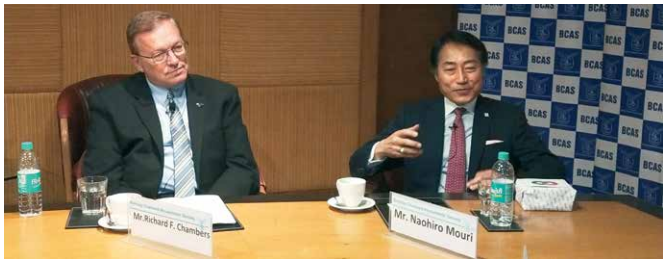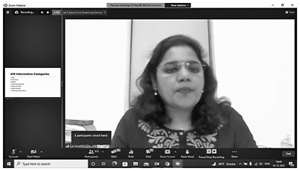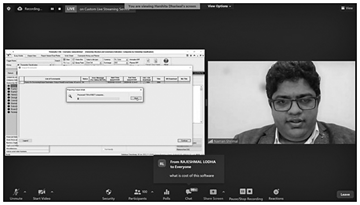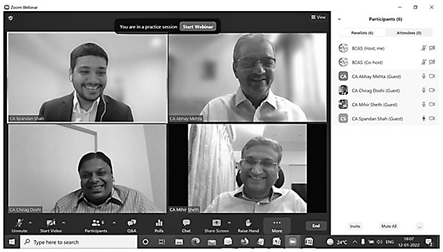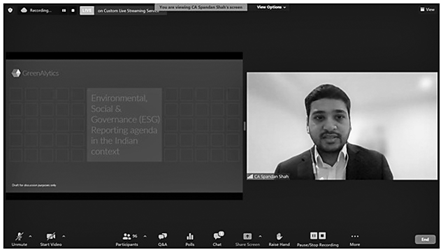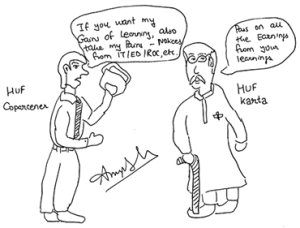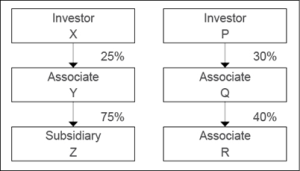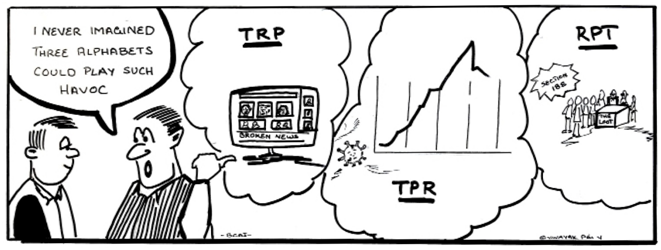Rapid globalisation and the increasing use of technology has resulted in a significant increase in foreign remittances from India. Given the onerous responsibility of a practitioner to certify the tax liability of the non-resident recipient to a foreign remittance, it is imperative that one is aware of the various interpretations available, and takes an informed view while issuing Form 15CB.
Over a series of articles, the authors seek to analyse the withholding tax implications and some of the issues arising on some of the common remittances. While all forms of remittances may not be covered in this article, the authors’ objective is to provide comprehensive coverage of the limited types of remittances.
In this first part of the series, we have analysed payments regarding export commission.
1. BACKGROUND
Let us consider the payment of export commission to an agent situated outside India. The activities undertaken by such an agent would typically include marketing the goods in the country of sale, identifying the buyer, coordinating with the buyer on the logistical aspects of the sale, and placing the order for the goods with the buyer. The activities of such an agent may also include receiving goods from the principal and delivering it to the buyer. For such activities, the agent may charge a fixed commission to its principal situated in India.
2. WHETHER THE INCOME OF SUCH AGENT WOULD ACCRUE OR ARISE IN INDIA?
Section 5 of the Income Tax Act, 1961 (‘the Act’) provides that income of a non-resident would be taxable in India if such income:
a. Is received or is deemed to be received in India; or
b. Accrues or arises or is deemed to accrue or arise in India.
In the case of export commission paid to a non-resident agent, generally such income is paid outside India and is therefore, not received in India. Therefore, one would need to evaluate whether such income is accruing or arising in India or is deemed to accrue or arise in India.
In this regard, Circular No. 23 of 1969 throws some light on the matter by providing the following:
“3.4 A foreign agent of Indian exporter operates in his own country and no part of his income arises in India..”
Therefore, the Circular provided that in respect of a non-resident agent, commission income from export would not be considered as accruing or arising in India.
While the Circular has since been withdrawn, the principle emanating from the Circular should apply even after the withdrawal.
There are various judicial precedents which have held that the income of such agent would not be considered as accruing or arising in India.
The Delhi ITAT in the case of Welspring Universal vs. JCIT [2015] 56 taxmann.com 174, held:
“4…….In the context of rendering of services for procuring export orders by a non-resident from the countries outside India, there can be no way for considering the actual export from India as the place for the accrual of commission income of the non-resident. One should keep in mind the distinction between the accrual of income of exporter from exports and that of the foreign agent from commission. As a foreign agent of Indian exporter operates outside India for procuring export orders and further the goods in pursuance to such orders are also sold outside India, no part of his income can be said to accrue or arise in India.”
Interestingly, in the above case, the Tribunal distinguished between the source of income for the foreign agent vis-à-vis that for the exporter. The source of income for the exporter, as held by the Chennai ITAT in the case of DCIT vs. Alstom T & D India Ltd. (2016) 68 taxmann.com 336, would be the place where the manufacturing activities are undertaken or where the export contract has been entered into. On the other hand, for the foreign agent, the source of his income i.e. commission on the sale of goods would depend on where the services are rendered by such agent.
Prior to the amendment in Explanation to section 9(1)(vii) of the Act, the Supreme Court in the case of Ishikawajima-Harima Heavy Industries Ltd. vs. DCIT (2007) 288 ITR 408 held that even if the services are considered as fees for technical services (‘FTS’), if such services are not rendered in India, the income arising from such services would not be considered as accruing or arising in India. While the above decision of the Apex Court has been overruled by the amendment vide Finance Act 2010 (with retrospective effect from 1st June, 1976), the principle arising from the decision would still apply in the case of services rendered (to the extent the same is not considered as FTS) outside India.
The Karnataka High Court in the case of PCIT vs. Puma Sports India (P.) Ltd. (2021) 434 ITR 69 held that commission paid to a non-resident agent for placing orders with manufacturers outside India would not be liable to tax in India as such services were rendered as well as utilized outside India. Therefore, no taxing event had taken place within the territories of India. The Supreme Court dismissed the SLP filed by the Revenue against the above High Court order (2022) 134 taxmann.com 60.
3. WHETHER SUCH INCOME IS DEEMED TO ACCRUE OR ARISE IN INDIA UNDER SECTION 9(1)(i)
The next question which arises is whether such income is deemed to accrue or arise in India under section 9 of the Act. While the question as to whether such income is considered as FTS under section 9(1)(vii) of the Act has been analysed in the ensuing paragraphs, let us first evaluate whether section 9(1)(i) of the Act could bring the commission income of a non-resident agent from services rendered to the principal outside India, to tax in India.
Section 9(1)(i) of the Act deems the following income to accrue or arise in India:
a. Income accruing or arising, directly or indirectly, through or from any business connection in India;
b. Income accruing or arising, through or from any property in India;
c. Income accruing or arising, through or from any asset or source of income in India; or
d. Income accruing or arising, through the transfer of a capital asset situated in India.
With regards to the first limb, the Supreme Court in the case of CIT vs. R.D. Aggarwal and Co. (1965) 56 ITR 20, has laid down the broad principle for defining the term ‘business connection’. In the context of section 42(1) of the Income Tax Act, 1922, similar to the provisions of section 9(1)(i) of the Act, the Apex Court held as follows:
“The expression “business connection” undoubtedly means something more than “business”. A business connection in section 42 involves a relation between a business carried on by a non-resident which yields profits or gains and some activity in the taxable territories which contributes directly or indirectly to the earning of those profits or gains. It predicates an element of continuity between the business of the non-resident and the activity in the taxable territories: a stray or isolated transaction is normally not to be regarded as a business connection. Business connection may take several forms: it may include carrying on a part of the main business or activity incidental to the main business of the non-resident through an agent, or it may merely be a relation between the business of the non-resident and the activity in the taxable territories, which facilitates or assists the carrying on of that business. In each case the question whether there is a business connection from or through which income, profits or gains arise or accrue to a non-resident must be determined upon the facts and circumstances of the case.
A relation to be a “business connection” must be real and intimate, and through or from which income must accrue or arise whether directly or indirectly to the non-resident. ….
…. Income not taxable under section 4 of the 1922 Act of a non-resident becomes taxable under section 42(1) of the 1922 Act, if there subsists a connection between the activity in the taxable territories and the business of the non-resident, and if through or from that connection income directly or indirectly arises.”
Therefore, in order for business connection [other than the provisions of Significant Economic Presence (‘SEP’), which have been discussed subsequently in this article] to exist, there needs to be a business activity continuously undertaken in the country. In other words, in the absence of any business activities undertaken in India, a business connection may not be constituted.
This is also evident from Explanation 1 to section 9(1)(i) of the Act which provides as follows:
“(a) in the case of a business, other than the business having business connection in India on account of significant economic presence, of which all the operations are not carried out in India, the income of the business deemed under this clause to accrue or arise in India shall be only such part of the income as is reasonably attributable to the operations carried out in India ;”
Therefore, except in the case of a business connection on account of the SEP provisions, only such part of the income as is reasonably attributable to operations carried out in India can be considered as income deemed to accrue or arise in India.
In this regard, the Supreme Court, in the case of CIT vs. Toshoku Ltd. (1980) 125 ITR 525, had analysed whether the export commission paid to non-resident agents would be considered as income deemed to accrue or arise in India.
In that case, the assessee was an exclusive sales agent of tobacco in Japan and France for an Indian exporter. The assessee, for its services rendered, received commission from the Indian exporter. Without evaluating whether ‘business connection’ of the non-resident assessee was constituted in India, the Supreme Court held that in the absence of any activities undertaken by the non-resident assessee in India, no income could be considered as attributable to any operations in India and therefore, no income could be considered as deemed to accrue or arise in India.
The second limb of section 9(1)(i) of the Act refers to income accruing through or from a property situated in India. Arguably, sale of goods may not be considered as sale of property. Moreover, even in case such sale of goods is considered as sale of property, one may be able to argue that section 9(1)(i) refers to income accruing through or from a property situated in India and income from the sale of such property would not qualify as income from a property (such as rental income) nor as income through a property. Additionally, one can also argue that the commission income, being income from services rendered in relation to the sale of goods, is one step further away from income from sale of property and income through or from property.
The third limb of section 9(1)(i) of the Act refers to income accruing or arising through or from any asset or source in India. As discussed above, income from services rendered towards sale of goods may not be considered as income accruing or arising through or from any asset in India. Interestingly, the AAR in the case of Rajiv Malhotra, In re (2006) 284 ITR 564, held that export commission would be considered as income accruing or arising through or from a source of income in India.
In that case, the assessee was organising an exhibition in India and had appointed foreign agents to furnish information to foreign participants about the exhibition and for booking space in the exhibition. Such agents would be rendering the services outside India, and no services by the agents were rendered in India. The agents were responsible for planning, directing and executing the sales campaign for the assessee and the exhibition in the foreign jurisdictions. The agent would receive the commission only on participation by the exhibitors in the exhibition in India.
The AAR held that the fact that the income of the agent was dependent on the participation by the exhibitors (customers) in India would mean that the source of income for the non-resident agent would be considered to be in India. The AAR further also held that the fact that the services by the agents were rendered outside India would be of no consequence.
The above decision of the AAR was also followed in the decision by the same authority in the case of SKF Boilers and Driers (P.) Ltd., In re (2012) 343 ITR 385.
In the view of the authors, with the utmost respect to the AAR, the above decisions of the AAR may not be considered as an appropriate analysis of the matter on account of the following reasons:
a. The AAR did not consider the decision of the Supreme Court in the case of Toshoku Ltd. (supra), wherein the commission received by non-resident agents was considered to be accruing or arising outside India and hence not taxable; and
b. The AAR did not consider the impact of Explanation 1(a) to section 9(1)(i) of the Act. Even if the decision of the AAR is considered, the fact that no operations of the agent are actually undertaken in India would result in no attribution of income of the agent to be deemed to accrue or arise in India.
Therefore, subject to the applicability of the SEP provisions, analysed in para 6 below, export commission earned by a non-resident agent would not be deemed to accrue or arise in India under section 9(1)(i) of the Act.
4. WHETHER THE SERVICES RENDERED BY THE AGENT CAN BE CONSIDERED AS FEES FOR TECHNICAL SERVICES
The other sub-clauses of section 9(1) of the Act – dealing with salary, interest and royalty would not be applicable in this case. One would now need to analyse whether the services rendered by the commission agent would be considered as FTS under section 9(1)(vii) of the Act. There are various decisions discussing various facets of the FTS clause, and this article does not cover all such case laws on the matter. This article covers those case laws relevant to the type of payment, i.e. export commission and the taxability thereof.
The crux of the matter is whether the consideration received by a commission agent would be considered as towards rendering of services. In this regard, one may refer to the Ahmedabad ITAT in the case of DCIT vs. Welspun Corporation Ltd. (2017) 77 taxmann.com 165, wherein it has been held that the agent receives the commission on securing order and not for the provision of the services. The reasoning provided by the ITAT is as under:
“Even proceeding on the assumption that these non-resident agents did render the technical services, which, is an incorrect assumption any way, what is important to appreciate is that the amounts paid by the assessee to these agents constituted consideration for the orders secured by the agents and not the services alleged rendered by the agents. The event triggering crystallization of liability of the assessee, under the commission agency agreement, is the event of securing orders and not the rendition of alleged technical services. In a situation in which the agent does not render any of the services but secures the business any way, the agent is entitled to his commission which is computed in terms of a percentage of the value of the order. In a reverse situation, in which an agent renders all the alleged technical services but does not secure any order for the principal i.e. the assessee, the agent is not entitled to any commission. Clearly, therefore, the event triggering the earnings by the agent is securing the business and not rendition of any services. In this view of the matter, the amounts paid by the assessee to its non-resident agents, even in the event of holding that the agents did indeed render technical services, cannot be said to be ‘consideration for rendering of any managerial, technical or consultancy services’…..The work actually undertaken by the agent is the work of acting as agent and so procuring business for the assessee but as the contemporary business models require the work of agent cannot simply and only be to obtain the orders for the product, as this obtaining of orders is invariably preceded by and followed by several preparatory and follow up activities. The description of agent’s obligation sets out such common ancillary activities as well but that does not override, or relegate, the core agency work. The consideration paid to the agent is also based on the business procured and the agency agreements do not provide for any independent, standalone or specific consideration for these services.”
Therefore, the Ahmedabad ITAT in the above case held that the consideration received by the agent is towards the procurement of business and not for services rendered.
However, generally, the revenue authorities also seek to tax the export commission as FTS, given the sheer number of judicial precedents on the issue. Therefore, it is important to analyse whether such commission can be classified as FTS under section 9(1)(vii).
The term ‘fees for technical services’ broadly covers the following categories of services:
• Managerial services;
• Technical services; and
• Consultancy services.
The terms ‘managerial’, ‘technical’ or ‘consultancy’ have not been defined in the Act, and therefore, one would need to understand these terms in common parlance.
4.1 MANAGERIAL SERVICES
Black’s Law Dictionary defines the terms ‘manage’ to mean the following:
“To conduct; to carry on the concerns of a business or establishment.”
Further, the term ‘manager’ is defined to mean the following:
“One who has charge of corporation and control of its business or branch establishment, and who is vested with a certain amount of discretion and independent judgment.”
Having looked at the dictionary meaning of the term ‘manage’, the question arises as to what is meant by managerial services, specifically – managing a particular function of an entity such as purchase or sales or managing the entity as a whole, akin to a director of a company.
The issue as to what is meant by ‘managerial services’ and whether the services rendered by a commission agent would constitute managerial services have been analysed by the Mumbai ITAT in the case of Linde AG vs. ITO (1997) 62 ITD 330, albeit in the context of a procurement agent. In the said case, the assessee procured certain materials and spares required to set up a fabrication plant in Gujarat. These purchases were charged from the Indian concern, i.e. Gujarat State Fertilizers Company, at cost plus 4% procurement charges. Referring to the decision of the Delhi High Court in the case of J.K. (Bombay) Ltd. vs. CBDT & Anr. (1979) 118 ITR 312 in the context of section 80-O of the Act, the ITAT held as under:
“Their Lordships of Delhi High Court referred to an article on ‘Management Sciences’ in 14 Encyclopaedia 747, wherein it is stated that the management in organisations include at least the following:
(a) discovering, developing, defining and evaluating the goals of the organisation and the alternative policies that will lead towards the goals;
(b) getting the organisation to adopt the policies;
(c) scrutinising the effectiveness of the policies that are adopted and
(d) initiating steps to change policies when they are judged to be less effective than they ought to be.
The third category is managerial service. The managerial service, as aforesaid, is towards the adoption and carrying out the policies of a organisation. It is of permanent nature for the organisation as a whole. In making the stray purchases, it cannot be said that the assessee has been managing the affairs of the Indian concern or was rendering managerial services to the assessee.”
Therefore, while holding that procurement services would not constitute managerial services, the ITAT explained that managerial services would refer to carrying out the organisation’s policies as a whole.
In this regard, as the broad range of services rendered by an export agent as well as a procurement agent is similar, albeit, for two different ends of a transaction, their taxability would also be similar. Therefore, any decision in respect of taxability of income of a procurement agent (for procurement outside India) would equally apply to the export commission earned by an agent.
The Authority for Advance Rulings in the case of Intertek Testing Services India (P.) Ltd., In re (2008) 307 ITR 418 held the term ‘managerial services’ to mean the following:
“Thus, managerial services essentially involves controlling, directing or administering the business.”
In the context of export commission, the Delhi High Court in the case of DIT (International Taxation) vs. Panalfa Autoelektrik Ltd. (2014) 272 CTR 117, held as follows:
“The services rendered, the procurement of export orders, etc. cannot be treated as management services provided by the non-resident to the respondent-assessee. The non-resident was not acting as a manager or dealing with administration. It was not controlling the policies or scrutinising the effectiveness of the policies. It did not perform as a primary executor, any supervisory function whatsoever.”
This differentiation between ‘execution’ and ‘management’ has also been explained by the Mumbai ITAT in the case of UPS SCS (Asia) Ltd. vs. ADIT (2012) 50 SOT 268, wherein it has been held that:
“Ordinarily the managerial services mean managing the affairs by laying down certain policies, standards and procedures and then evaluating the actual performance in the light of the procedures so laid down. The managerial services contemplate not only execution but also the planning part of the activity to be done. If the overall planning aspect is missing and one has to follow a direction from the other for executing particular job in a particular manner, it cannot be said that the former is managing that affair. It would mean that the directions of the latter are executed simplicity without there being any planning part involved in the execution and also the evaluation of the performance. In the absence of any specific definition of the phrase “managerial services” as used in section 9(1)(vii) defining the “fees for technical services”, it needs to be considered in a commercial sense. It cannot be interpreted in a narrow sense to mean simply executing the directions of the other for doing a specific task. …….. On the other hand, ‘managing’ encompasses not only the simple execution of a work, but also certain other aspects, such as planning for the way in which the execution is to be done coupled with the overall responsibility in a larger sense. Thus it is manifest that the word ‘managing’ is wider in scope than the word ‘executing’. Rather the latter is embedded in the former and not vice versa.”
The Chennai ITAT in the case of DCIT vs. Mainetti (India) P. Ltd. (2011) 46 SOT 137 held that canvassing for orders would not constitute managerial services.
Similarly, Madras High Court in the case of Evolv Clothing Co. (P.) Ltd. vs. ACIT (2018) 407 ITR 72 held that market survey undertaken incidental to the services of a commission agent would also not be considered as fees for technical services under section 9(1)(vii).
Further, as regards whether one can argue that one is providing managerial services if one is managing the purchase/sales function, the ITAT in the case of Linde AG (supra) held as under:
“The Learned Departmental Representative brought to our notice a concept of ‘marketing management’ but such marketing services are to be, as aforesaid, on a regular basis, i.e. when the purchases of the assessee on a permanent or semi-permanent or at regular interval basis. It does not include the purchases made only to be utilised for a particular venture taken up by the assessee, which in this case is fabrication of a new scientific plant. It being a one-time job and not marketing management of making purchases by the assessee for the new concern.”
Therefore, one can conclude based on the above observation by the Mumbai ITAT that if the purchase or sales function of the entire organisation has been completely outsourced to an agent, then the services rendered by such agent may be considered as managerial services. For example, if an entity within the entire MNE group is in charge of undertaking the entire purchase or sales function of all the entities within the MNE and such entity is also deciding the policies of such function, one may possibly consider such services managerial services.
4.2 TECHNICAL SERVICES
The second limb of the definition of FTS is ‘technical service’. The Merriam – Webster dictionary defines the term ‘technical’ to mean “as having special and usually practical knowledge especially of a mechanical or scientific subject”
Similarly, the Collins dictionary defines the term as “of, relating to, or specializing in industrial, practical, or mechanical arts and applied sciences”.
Therefore, in common parlance, one may say that technical services would mean services which require application of industrial, mechanical or applied sciences.
The Madras High Court in the case of Skycell Communications Ltd. & Anr. vs. DCIT & Ors (2001) 251 ITR 53 has provided guidance as to what would be considered as ‘technical services’ as under:
“Thus while stating that “technical service” would include managerial and consultancy service, the Legislature has not set out with precision as to what would constitute “technical” service to render it “technical service”. The meaning of the word “technical” as given in the New Oxford Dictionary is adjective 1. of or relating to a particular subject, art or craft or its techniques: technical terms (especially of a book or article) requiring special knowledge to be understood: a technical report. 2. of involving, or concerned with applied and industrial sciences: an important technical achievement. 3. resulting from mechanical failure: a technical fault. 4. according to a strict application or interpretation of the law or the rules: the arrest was a technical violation of the treaty.
Having regard to the fact that the term is required to be understood in the context in which it is used, “fee for technical services” could only be meant to cover such things technical as are capable of being provided by way of service for a fee. The popular meaning associated with “technical” is “involving or concerning applied and industrial science”.”
Interestingly, the Memorandum of Understanding to the DTAA between India and US provides as follows:
“Article 12 includes only certain technical and consultancy services. But technical services, we mean in this context services requiring expertise in a technology.”
While the term ‘technology’ refers to machines and processes, the term ‘technical’ would be wider and would cover applied and mechanical sciences and would mean a kind of specialized or complex knowledge.
Therefore, the meaning under the MOU in the India – US DTAA may be restricted in application to the India – US DTAA only as it provides a narrower meaning than used in common parlance.
Having understood the meaning of the term ‘technical services’, the issue arises is whether the services rendered by a commission agent could be considered as ‘technical services’. In this regard, the Delhi High Court in the case of Panalfa Autoelektrik Ltd. (supra) held as follows:
“The non-resident had not undertaken or performed “technical services”, where special skills or knowledge relating to a technical field were required. Technical field would mean applied sciences or craftsmanship involving special skills or knowledge but not fields such as arts or human sciences.”
On the other hand, the Cochin ITAT in the case of ITO vs. Device Driven (India) (P.) Ltd. (2014) 29 ITR (T) 263 held that export commission in case of software was considered as technical services. In this regard, the ITAT held as under:
“Software is a highly technical product and it is required to be developed in accordance with the requirements of the customers. Even after the development, it requires constant monitoring so that necessary modifications are required to be carried out in order to make it suitable to the requirements. The work of the assessee company also does not end upon developing and installing the software at the client’s site. As stated earlier, it requires on-site monitoring, especially when the customized software is developed. Hence, in our view, it cannot be equated with the commodities, where the role of the Commission agent normally ends after supply of goods and receipt of money. Hence, in the case of software companies, the sales agent should also possess required technical knowledge and then only he could procure orders for the company by understanding the needs of clients and further convincing them..….. As per the clauses of the agreement, which are extracted above, the Commission agent is responsible in securing orders and for that purpose only he has to assist the assessee company in all respects including identifying markets, making introductory contacts, arranging meeting with prospective clients, assisting in preparation of presentations for target clients. His duty does not end on securing the orders, but he has to monitor the status and progress of the project, meaning thereby the Commission agent is responsible for ensuring supply of the software and also for receiving the payments. All these activities, in our view, could be carried on only by a person who is having vast technical knowledge and experience. Hence, we agree with the tax authorities’ view that the payment made to Shri Balaji Bal constitutes the payment made towards technical services.”
Interestingly, the Cochin ITAT equated the nature of product sold by the agent with the nature of services rendered by the agent. With due respect to the Cochin ITAT, the authors are of the view that it may not be appropriate to equate the product sold with the service rendered. The ITAT in the above case did not list out any specific services required to be rendered by an agent distributing software that would be different from that distributing other commodities. For example, even if one sells an iron rod, one is required to have certain knowledge of the product sold to enable him to match the client’s requirement with the product and sell the product. Further, identifying markets, arranging meeting with prospective clients, preparing presentations for target clients, and ensuring that the product is smoothly delivered is something an agent selling any product may be required to undertake.
In this regard, the Ahmedabad ITAT in the case of Welspun Corporation Ltd. (supra) has succinctly segregated the nature of service from the nature of product sold. It has held as follows:
“Just because a product is highly technical does not change the character of activity of the sale agent. Whether a salesman sells a handcrafted souvenir or a top of the line laptop, he is selling nevertheless. It will be absurd to suggest that in the former case, he is selling and the latter, he will be rendering technical services. The object of the salesman is to sell and familiarity with the technical details, whatever be the worth of those technical details, is only towards the end of selling. In a technology driven world that we live in, even simplest of day to day gadgets that we use are fairly technical and complex. Undoubtedly when a technical product is being sold, the person selling the product should be familiar with technical specifications of the product but then this aspect of the matter does not any way change the economic activity.”
On the other hand, it is also important to highlight that the above Cochin ITAT decision was upheld by the Kerala High Court in the case of the same assessee in Device Driven (India) P Ltd. vs. CIT (2021) 126 taxmann.com 25. However, the Kerala High Court did not analyse the services rendered by the agent to determine whether the services were ‘technical services’ but relied more on the argument that the services were rendered for earning source outside India, and therefore, not accruing or arising in India.
4.3 CONSULTANCY SERVICES
The last limb of the definition of the term FTS is ‘consultancy services’.
In common parlance, ‘to consult’ would mean ‘to advise’. With regards to the overlap with technical services, the MOU in the India – US DTAA provides as under:
“By consultancy services, we mean in this context advisory services. The categories of technical and consultancy services are to some extent overlapping because a consultancy service could also be a technical service. However, the category of consultancy services also includes an advisory service, whether or not expertise in a technology is required to perform it.”
The Supreme Court in the case of GVK Industries Ltd. & Anr. vs. ITO & Anr. (2015) 371 ITR 453 evaluated the meaning of ‘consultancy services’ under section 9(1)(vii). In the said case, a non-resident company rendered services related to raising finance for the assessee, which included, inter alia, financial structure and security package to be offered to the lender, making an assessment of export credit agencies worldwide and obtaining commercial bank support on the most competitive terms, assisting the appellant loan negotiations and documentation with lenders and structuring, negotiating and closing the financing for the project in a co-ordinated and expeditious manner.
“The word ‘consultation’ has been defined as an act of asking the advice or opinion of someone (such as a lawyer). It means a meeting in which a party consults or confers and eventually it results in human interaction that leads to rendering of advice. The NRC had acted as a consultant. It had the skill, acumen and knowledge in the specialized field i.e. preparation of a scheme for required finances and to tie-up required loans. The nature of service rendered by the NRC, can be said with certainty would come within the ambit and sweep of the term ‘consultancy service’ and, therefore, it has been rightly held that the tax at source should have been deducted as the amount paid as fee could be taxable under the head ‘fees for technical services’.”
Similarly, the AAR in the case of Guangzhou Usha International Ltd., In re (2015) 378 ITR 465 held that where the agent was not only identifying new products but also generating new ideas for the principal after market research, evaluating credit, finance, organisation, production facility, etc. and on the basis of the evaluation, giving advice to the principal, the services rendered by such agent would be considered as ‘consultancy services’.
However, the Delhi High Court in the case of Panalfa Autoelektrik Ltd. (supra) as well as the Mumbai ITAT in the case of Linde AG (supra) have held that services rendered by an agent would not constitute ‘consultancy services’.
On similar lines, the Delhi High Court in the case of CIT vs. Grup Ism (P.) Ltd. (2015) 378 ITR 205 held that export commission would not be considered as ‘consultancy services’ even though the nomenclature of the transaction as per the agreement was of ‘consultancy services’. It held as follows:
“‘Consultancy services’ would mean something akin to advisory services provided by the non-resident, pursuant to deliberation between parties. Ordinarily, it would not involve instances where the non-resident is acting as a link between the resident and another party, facilitating the transaction between them, or where the non-resident is directly soliciting business for the resident and generating income out of such solicitation. The mere fact that CGS confirmed that it received consultancy charges from the assessee would not be determinative of the issue. The actual nature of services rendered by CGS and MAC needs to be examined for this purpose.”
From the above jurisprudence, it is clear, in the view of the authors, that export commission by itself would not be considered as ‘consultancy services’. However, if the agent provides advisory services along with the export commission, one may need to evaluate the predominant nature of services to determine the characterisation of the transaction.
5. WHETHER THE WITHDRAWAL OF CIRCULAR NO. 23 OF 1969 WOULD RESULT IN TAXABILITY
As discussed above, the CBDT Circular No. 23 of 1969 had clarified non-taxability in India for commission earned by a foreign non-resident agent. This Circular was subsequently withdrawn stating that it did not reflect the correct position under section 9 of the Act. In this regard, the question therefore, arises is whether the withdrawal of the Circular can result in the taxation of the commission earned by a foreign agent.
In this regard, the Delhi ITAT in the case of Welspring Universal vs. JCIT (supra) held as follows:
“11. ….The legal position contained in section 5(2) read with section 9, as discussed above about the scope of total income of a non-resident subsisting before the issuance of circular nos. 23 and 786 or after the issuance of circular no. 786 has not undergone any change. It is not as if the export commission income of a foreign agent for soliciting export orders in countries outside India was earlier chargeable to tax, which was exempted by the CBDT through the above circulars and now with the withdrawal of such circulars, the hitherto income not chargeable to tax, has become taxable. The legal position remains the same de hors any circular in as much as such income of a foreign agent is not chargeable to tax in India because it neither arises in India nor is received by him in India nor any deeming provision of receipt or accrual is attracted. It is further relevant to note that the latter Circular simply withdraws the earlier circular, thereby throwing the issue once again open for consideration and does not state that either the export commission income has now become chargeable to tax in the hands of the foreign residents or the provisions of section 195 read with sec. 40(a)(i) are attracted for the failure of the payer to deduct tax at source on such payments.
12. Ex consequenti, we hold that the amount of commission income for rendering services in procuring export orders outside India is not chargeable to tax in the hands of the non-resident agent and hence no tax is deductible under section 195 on such payment by the payer.”
The authors are also of a similar view that the legal position upheld by various courts does not change, and the export commission earned by a non-resident agent may still not be liable to tax in India.
6. WHETHER THE PROVISIONS OF SEP CAN TRIGGER IN THE CASE OF EXPORT COMMISSION
The Finance Act, 2018 has introduced the significant economic presence (‘SEP’) provisions in India. Explanation 2A to section 9(1)(i) of the Act extends the definition of business connection to include SEP and SEP has been defined to mean the following:
(a) transaction in respect of any goods, services or property carried out by a non-resident with any person in India including provision of download of data or software in India, if the aggregate of payments arising from such transaction or transactions during the previous year exceeds such amount as may be prescribed; or
(b) systematic and continuous soliciting of business activities or engaging in interaction with such number of users in India, as may be prescribed:
Further, the Proviso to the Explanation also provides that the transactions or activities shall constitute SEP, whether or not:
(i) the agreement for such transactions or activities is entered in India; or
(ii) the non-resident has a residence or a place of business in India; or
(iii) the non-resident renders services in India
In other words, the SEP provisions apply even if such services are rendered outside India if it is undertaken with any person in India and if the aggregate payments during the year exceed the threshold prescribed.
Further, the CBDT vide Notification No. 41/2021/F.No.370142/11/2018-TPL dated 3rd May, 2021, has notified the thresholds to mean INR 2 crore in the case of payments referred to in clause (a) above and 3 million users in clause (b) above.
The authors have analysed the SEP provisions in detail in their article in the March, 2021 edition of BCAJ Journal.
Therefore, now, if the services rendered by the commission agent exceed INR 2 crore in a financial year, such non-resident agent may be considered as having a business connection in India due to the SEP provisions under section 9(1)(i) of the Act.
7. CONCLUDING REMARKS
In this article, the authors have analysed the taxability of export commission in detail. To summarize, the commission earned by a non-resident in respect of agency services rendered for exports, where no activities are undertaken in India, would not be taxable in India under the Act. However, one would need to evaluate if there are any additional services rendered by such an agent, such as managing the entire purchase or sale function of an organisation which could result in taxability under the Act or the relevant tax treaty as FTS. Moreover, one may need to also evaluate if the payments to the agent during the year exceed INR 2 crore, in which case the SEP provisions may apply, resulting in taxability of the commission earned by such non-resident agent on account of the business connection being constituted in India. In such a scenario, one may still be able to apply the provisions of the DTAA and such income may not be taxable in the absence of a PE of such agent in India, subject to the requirement of documents such as tax residency certificate, etc as well as fulfilling the conditions as may be provided in the OECD Multilateral Instrument, if applicable.

